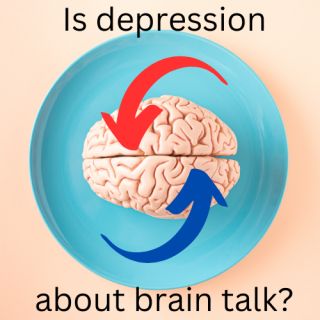Depression
How Does Brain Stimulation Reduce Depression?
New research suggests the direction of brain signals can predict improvement.
Posted May 21, 2023 Reviewed by Gary Drevitch
Key points
- New research examined changes in "resting state" brain activity related to reduced depression in patients.
- Researchers examined responses to a new treatment called Stanford Neuromodulation Therapy (SNT).
- Changes in the direction of signalling between two brain regions, the ACC and the insula, were key.
- In depressed people, the ACC may filter sensations through a sad mood, instead of responding normally.

Newly published research has found a specific change in brain functioning related to people’s response to brain stimulation for depression. The researchers examined changes in brain function after people received Transcranial Magnetic Stimulation (TMS) treatment, which involves stimulating the brain with a magnet at a specific location associated with depression. This approach to treating depression was first approved by the FDA in 2008. In 2021, a new version of TMS treatment called Stanford Neuromodulation Therapy (SNT) was approved. This updated version of the treatment has two major changes: finding personalized brain locations to stimulate, based on a person’s brain scan; and delivering all the needed treatment sessions in 5 days as opposed to 30. Results show that SNT improves depression even in cases when medications don’t work, but there are still questions about exactly what is changing in the brain during this treatment. The new research dives into this open question: How does SNT change the brain?
Previous research has looked for clues about how brain stimulation works by examining resting-state functional connectivity. That means it examined how brain areas interact with each other while an individual is “resting”—just sitting quietly in a brain scanner, not doing anything specific. This is typically done by examining which parts of the brain are activated at the same time. The new study, led by researcher Anish Mitra, took a slightly different approach: It examined the flow of information over time. This approach tries to capture how signals are passed from one area of the brain to another. It was this “directed signaling” in the brain that predicted response to the SNT treatment.
The better someone got after treatment, the later their anterior cingulate cortex (ACC) was activated. The ACC is a brain region related to emotion, motivation, and attention. Activity in the ACC has also been related to depression, specifically. So it makes sense that ACC activity would be identified in the new analysis. What’s new about this analysis is that it finds that recovery from depression involves late ACC activation, suggesting that the ACC is responding to other brain regions—as opposed to sending signals out to change those brain regions.
When they dug into this effect, the researchers found that the communication between the ACC and another brain region, the insula, was key. The insula is a brain region that integrates different sensations in the body. In an interview with Stanford News Center’s Nina Bai, researcher Anish Mitra described the interaction between the brain regions this way:
“You could think of it as the anterior cingulate cortex [ACC] receiving this information [from the insula] about the body — like heart rate or temperature — and then deciding how to feel on the basis of all these signals … What we saw is that who’s the sender and who’s the receiver in the relationship seems to really matter in terms of whether someone is depressed.”

When the ACC signal was late—suggesting it was changing in response to information from the insula—people had a better response to treatment. When the ACC signal was early—suggesting it was changing the activity of the insula, instead of reacting to information from the insula—people had a worse response. This pattern was also seen when comparing healthy and depressed people before treatment. The depressed people had an ACC that responded to the insula, and the non-depressed people had an insula that responded to the ACC.
Mitra explains what this pattern of signaling in depression means: “It’s almost as if you’d already decided how you were going to feel, and then everything you were sensing was filtered through that … The mood has become primary.” In more-depressed people, the mood determined by the ACC changed how they interpreted sensations from the body—potentially filtering sensations through a depressed mood.
This research helps to explain what changes in the brain when TMS treatment is successful: Information between two key brain areas flows in the wrong direction. This “backwards flow” suggests that depressed people are changing their internal interpretations of their situation based on their mood, as opposed to changing their mood based on how their situation has changed. This finding might be helpful in other ways, too. It appears that this “backwards flow” could be a marker in brain activity that helps doctors and researchers understand who has depression—and what needs to change to treat it.
References
Mitra, A., Raichle, M. E., Geoly, A. D., Kratter, I. H., & Williams, N. R. (2023). Targeted neurostimulation reverses a spatiotemporal biomarker of treatment-resistant depression. Proceedings of the National Academy of Sciences, 120(21), e2218958120.


